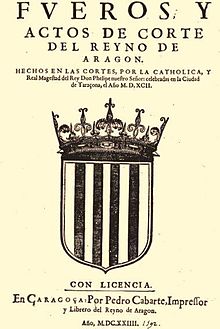Cortes of Tarazona (1592)
The king requested that, due to his other responsibilities and his state of health, the Cortes be allowed to be inaugurated and presided over by the Archbishop of Zaragoza, Andrés de Cabrera y Bobadilla, promising to attend to their closure.
The archbishop of Zaragoza died on August 25, after which the regent of the Supreme Council of Aragon was empowered to hold the solio of approval of the charter authorizing the making of decisions by a majority of the arms.
The king arrived in Tarazona on November 30, after the main culprits of the disturbances had been executed and the Count of Aranda and the Marquis Villahermosa had died in prison.
He also granted a general pardon to all those who were then imprisoned or indicted in Aragon for the disturbances, with the exception of the lieutenants of the Justice and lawyers who supported the resistance to the royal army, who were banished, and two more condemned.
[12] The royal army, except for the garrisons of the citadel of Jaca and the Aljafería of Zaragoza, left Aragon the following year, after the Moors were disarmed, with some units going to Italy, others to Roussillon and others returning to Castile.


